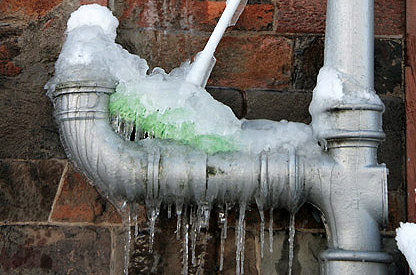Preventing Pipes from Cold Weather: Effective Methods
Preventing Pipes from Cold Weather: Effective Methods
Blog Article
The content down below on the subject of How to Prevent Your Pipes From Freezing is quite entertaining. Try it and draw your own personal ideas.
:strip_icc()/snow-outdoor-faucet-pipes-4af65d1e5e904fb1aa7bf74071fe5d89.jpg)
Cold weather can damage your pipes, specifically by freezing pipes. Here's just how to avoid it from happening and what to do if it does.
Intro
As temperatures drop, the danger of icy pipelines rises, potentially leading to pricey fixings and water damages. Comprehending just how to stop frozen pipes is important for house owners in chilly climates.
Prevention Tips
Insulating susceptible pipes
Wrap pipelines in insulation sleeves or make use of heat tape to protect them from freezing temperatures. Concentrate on pipelines in unheated or external areas of the home.
Heating methods
Maintain indoor rooms sufficiently warmed, especially locations with pipes. Open up cupboard doors to enable warm air to distribute around pipes under sinks.
How to determine frozen pipelines
Try to find lowered water circulation from taps, uncommon smells or noises from pipes, and noticeable frost on revealed pipes.
Long-Term Solutions
Architectural modifications
Consider rerouting pipelines far from outside walls or unheated locations. Include added insulation to attic rooms, basements, and crawl spaces.
Upgrading insulation
Purchase top notch insulation for pipes, attics, and wall surfaces. Appropriate insulation helps keep regular temperature levels and decreases the threat of frozen pipes.
Protecting Outdoor Plumbing
Garden tubes and outdoor taps
Disconnect and drain pipes garden pipes prior to wintertime. Mount frost-proof faucets or cover exterior faucets with shielded caps.
Comprehending Icy Pipelines
What creates pipelines to ice up?
Pipelines ice up when exposed to temperature levels below 32 ° F (0 ° C) for expanded durations. As water inside the pipes ices up, it expands, taxing the pipeline walls and possibly creating them to burst.
Threats and damages
Icy pipes can cause water disruptions, residential or commercial property damage, and costly repair services. Burst pipes can flooding homes and create extensive architectural damages.
Indicators of Frozen Pipeline
Recognizing frozen pipelines early can stop them from rupturing.
What to Do If Your Pipes Freeze
Immediate activities to take
If you believe icy pipes, maintain faucets open up to eliminate stress as the ice melts. Utilize a hairdryer or towels taken in hot water to thaw pipes slowly.
Conclusion
Preventing icy pipelines requires aggressive measures and quick actions. By comprehending the causes, indicators, and safety nets, home owners can safeguard their plumbing during winter.
5 Ways to Prevent Frozen Pipes
Drain Outdoor Faucets and Disconnect Hoses
First, close the shut-off valve that controls the flow of water in the pipe to your outdoor faucet. Then, head outside to disconnect and drain your hose and open the outdoor faucet to allow the water to completely drain out of the line. Turn off the faucet when done. Finally, head back to the shut-off valve and drain the remaining water inside the pipe into a bucket or container. Additionally, if you have a home irrigation system, you should consider hiring an expert to clear the system of water each year.
Insulate Pipes
One of the best and most cost-effective methods for preventing frozen water pipes is to wrap your pipes with insulation. This is especially important for areas in your home that aren’t exposed to heat, such as an attic. We suggest using foam sleeves, which can typically be found at your local hardware store.
Keep Heat Running at 65
Your pipes are located inside your walls, and the temperature there is much colder than the rest of the house. To prevent your pipes from freezing, The Insurance Information Institute suggests that you keep your home heated to at least 65 degrees, even when traveling. You may want to invest in smart devices that can keep an eye on the temperature in your home while you’re away.
Leave Water Dripping
Moving water — even a small trickle — can prevent ice from forming inside your pipes. When freezing temps are imminent, start a drip of water from all faucets that serve exposed pipes. Leaving a few faucets running will also help relieve pressure inside the pipes and help prevent a rupture if the water inside freezes.
Open Cupboard Doors
Warm your kitchen and bathroom pipes by opening cupboards and vanities. You should also leave your interior doors ajar to help warm air circulate evenly throughout your home.

Hopefully you enjoyed our section about How to prepare your home plumbing for winter weather. Thanks for taking time to browse our article post. So long as you enjoyed reading our article kindly consider to pass it around. I thank you for your readership.
Call Today Report this page